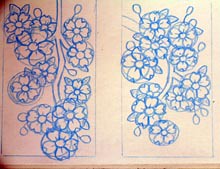 Some of you might be interested to learn about how I make these cards? If you were wondering about the process, then read on, for all will be explained. If you just want to see the finished cards, you can scroll down to the bottom of the post. Everybody wins!
Some of you might be interested to learn about how I make these cards? If you were wondering about the process, then read on, for all will be explained. If you just want to see the finished cards, you can scroll down to the bottom of the post. Everybody wins!
I start by drawing a sketch with a special "non-photo blue" colored pencil. These are great for sketching, because they use a particular shade of blue that's not detected by optical scanners. This way, when I scan it into the computer, the pencil lines don't show up--only my inks do.
My process at this point is fairly organic. I start out with a general idea for layout, but I might revise it as I go along. I draw the border rectangles by tracing a business card.
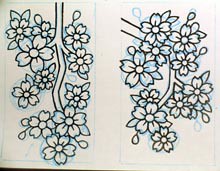 Once I have a satisfying sketch outline, I ink the image. I have done my first ink on the card on the left. On the right card, I've gone over my lines a second time to make them bold and correct any minor mistakes.
Once I have a satisfying sketch outline, I ink the image. I have done my first ink on the card on the left. On the right card, I've gone over my lines a second time to make them bold and correct any minor mistakes.
As I lay down ink, I often deviate from the sketch to add or modify elements of the design. Sometimes I sketch something but decide to leave it out of the inks, which you should be able to see in a few places where I omitted cherry buds.
I'm careful about inks and it's the most time-consuming part of the entire process, but sometimes I mess up, and I can fix that in Photoshop. The next step is to scan the image and lay it out on my card sheets.
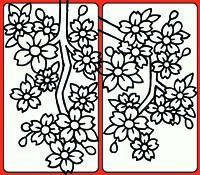 Here are both cards in their boxes. I draw each image at a larger size than the final card, so they overlap with the edges when I first drop them in. You can see them here before cropping.
Here are both cards in their boxes. I draw each image at a larger size than the final card, so they overlap with the edges when I first drop them in. You can see them here before cropping.
Forcing myself to cut off one or more sides of the picture adds an element of discovery that I enjoy. But, sometimes I draw the whole thing too big and have to shrink it. Or sometimes I have to move stuff around a little bit to make it look right in the final design. That's when I'm really glad we have computers that can do all of those things. Jenna is not so happy about it, because I am learning how nice it is to use Photoshop on her G5. I'm starting to use all the shortcut keys now, and it's awesome. We have to arm-wrestle for control of the stupid little round mouse (I still hate the Mac mouse).
 Coloring is the final step. I use the border red in at least one card for every suit. If it's appropriate, I also try to apply colors that I have already used in previous suits. Apart from that, I use whatever color strikes my fancy. On these cards, I picked a yellow from before and a brand-new pink for the blossoms.
Coloring is the final step. I use the border red in at least one card for every suit. If it's appropriate, I also try to apply colors that I have already used in previous suits. Apart from that, I use whatever color strikes my fancy. On these cards, I picked a yellow from before and a brand-new pink for the blossoms.
My Photoshop files are broken up into sheets of 10 cards. After I finish a card, I cut it out and upload it to Flickr to share with all of you. And that's the whole process! When I have completed the entire deck, I'll print it out on business cards.
I hope you enjoyed this "insider look" at the birth of a hanafuda card. If you've got any questions, ask away, and I'll answer 'em. Otherwise, check back in tomorrow to see the next card in the maple suit--drawn in the style that was voted most popular by you, my readers!
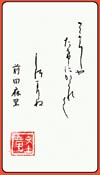
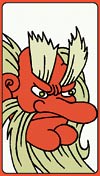 Tom Sloper shows an example of two "blank" cards here. On that page, the one on the left seems to be marked with an inspector's stamp, and the other is a mystery. I decorated mine with a calligraphic poem stolen from the nets, and stamped it with my own hand-carved hanko.
Tom Sloper shows an example of two "blank" cards here. On that page, the one on the left seems to be marked with an inspector's stamp, and the other is a mystery. I decorated mine with a calligraphic poem stolen from the nets, and stamped it with my own hand-carved hanko.
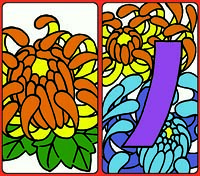 With the second half of the chrysanthemums on display here, I have completed every suit in the hanafuda deck! But that doesn't mean I'm done... not quite yet.
With the second half of the chrysanthemums on display here, I have completed every suit in the hanafuda deck! But that doesn't mean I'm done... not quite yet.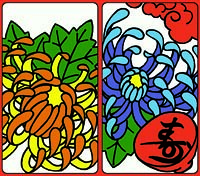 It is fitting that my final suit should be for the current month (September). These two cards portray a chrysanthemum junk (left) and on the right, the final "animal" card, which is
It is fitting that my final suit should be for the current month (September). These two cards portray a chrysanthemum junk (left) and on the right, the final "animal" card, which is 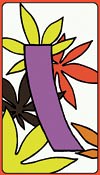
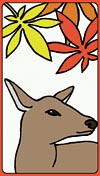 When I was in Japan with
When I was in Japan with 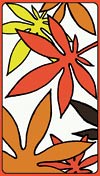 Here it is! By popular demand, more or less. This is the second card done up with my trademarked realistic-style maple leaves, which I will be using for the complete suit. I think it combines the best aspects of both designs from
Here it is! By popular demand, more or less. This is the second card done up with my trademarked realistic-style maple leaves, which I will be using for the complete suit. I think it combines the best aspects of both designs from  Some of you might be interested to learn about how I make these cards? If you were wondering about the process, then read on, for all will be explained. If you just want to see the finished cards, you can scroll down to the bottom of the post. Everybody wins!
Some of you might be interested to learn about how I make these cards? If you were wondering about the process, then read on, for all will be explained. If you just want to see the finished cards, you can scroll down to the bottom of the post. Everybody wins! Once I have a satisfying sketch outline, I ink the image. I have done my first ink on the card on the left. On the right card, I've gone over my lines a second time to make them bold and correct any minor mistakes.
Once I have a satisfying sketch outline, I ink the image. I have done my first ink on the card on the left. On the right card, I've gone over my lines a second time to make them bold and correct any minor mistakes. Here are both cards in their boxes. I draw each image at a larger size than the final card, so they overlap with the edges when I first drop them in. You can see them here before cropping.
Here are both cards in their boxes. I draw each image at a larger size than the final card, so they overlap with the edges when I first drop them in. You can see them here before cropping. Coloring is the final step. I use the border red in at least one card for every suit. If it's appropriate, I also try to apply colors that I have already used in previous suits. Apart from that, I use whatever color strikes my fancy. On these cards, I picked a yellow from before and a brand-new pink for the blossoms.
Coloring is the final step. I use the border red in at least one card for every suit. If it's appropriate, I also try to apply colors that I have already used in previous suits. Apart from that, I use whatever color strikes my fancy. On these cards, I picked a yellow from before and a brand-new pink for the blossoms.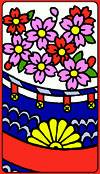 This card is the last of the "brights." Back in the day, during hanami, groups of cherry blossom viewers would use fancy curtains (
This card is the last of the "brights." Back in the day, during hanami, groups of cherry blossom viewers would use fancy curtains (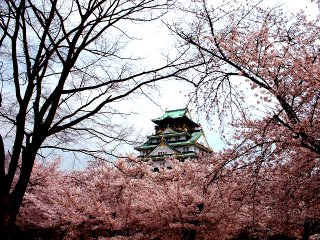
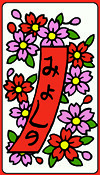 While I tally the votes for the dueling maples, let's move on to that most stereotypically Japanese flower, the cherry blossom. They're called
While I tally the votes for the dueling maples, let's move on to that most stereotypically Japanese flower, the cherry blossom. They're called 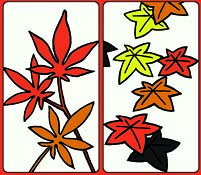 Let's get some reader participation into the artistic process! What you see here are two different styles of maple leaves, and I have to choose one as a template for the rest of the maple suit. I kind of like them both, but I can't decide which one to use. So, you get to decide for me!
Let's get some reader participation into the artistic process! What you see here are two different styles of maple leaves, and I have to choose one as a template for the rest of the maple suit. I kind of like them both, but I can't decide which one to use. So, you get to decide for me!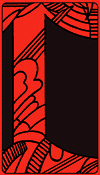 Whoa, what? That doesn't look like lightning, you may think, and you'd be correct! This is possibly the weirdest card in hanafuda. Besides its overall craziness, it also doesn't include any common elements from the other willow cards. It looks like the hanafuda artists dropped some acid before designing this one, and it's a distinctive card in every modern deck I looked at.
Whoa, what? That doesn't look like lightning, you may think, and you'd be correct! This is possibly the weirdest card in hanafuda. Besides its overall craziness, it also doesn't include any common elements from the other willow cards. It looks like the hanafuda artists dropped some acid before designing this one, and it's a distinctive card in every modern deck I looked at.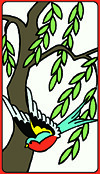 Here's the animal card for the willow/rain suit. Readers who know me very well may have seen this swallow somewhere before, since I have two of them tattooed on my chest! I got to cheat and use it again in my hanafuda deck, although it's not really cheating since I did the original bird design myself.
Here's the animal card for the willow/rain suit. Readers who know me very well may have seen this swallow somewhere before, since I have two of them tattooed on my chest! I got to cheat and use it again in my hanafuda deck, although it's not really cheating since I did the original bird design myself.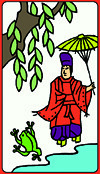 The subject of the "rain man" willow card is
The subject of the "rain man" willow card is 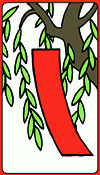 There's a lot going on in the willow suit, so I'm going to back off and do one card per day again until we're through it. For starters, there's only one 'junk' card in this suit, and it's a weird one. Most of the cards portray a willow tree, but it's alternately known as the "rain" suit. Finally, it's November in Japanese hanafuda, but December in Korea.
There's a lot going on in the willow suit, so I'm going to back off and do one card per day again until we're through it. For starters, there's only one 'junk' card in this suit, and it's a weird one. Most of the cards portray a willow tree, but it's alternately known as the "rain" suit. Finally, it's November in Japanese hanafuda, but December in Korea.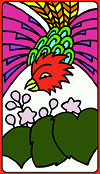 Behold the mighty phoenix, or, depending on which hanafuda page you read, possibly a chicken? Actually, it's not supposed to be either. A definitive source identifies this animal as the
Behold the mighty phoenix, or, depending on which hanafuda page you read, possibly a chicken? Actually, it's not supposed to be either. A definitive source identifies this animal as the 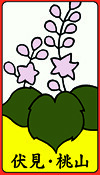 It all depends on what game you're playing, but in the rules of Japanese Koi Koi, the paulownia suit is the only one with three junk cards. However, the third one is decorated with a colored ground and (usually) the name of the manufacturer.
It all depends on what game you're playing, but in the rules of Japanese Koi Koi, the paulownia suit is the only one with three junk cards. However, the third one is decorated with a colored ground and (usually) the name of the manufacturer.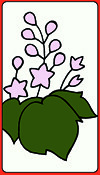
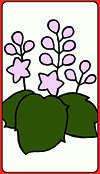 I didn't know what a wisteria looks like, but at least I had heard of it before. Paulowia? Yes, it's a real thing! Apparently it is a type of tree, and the flowers look a little something like the cards on your left, which are the two 'junks' from the suit.
I didn't know what a wisteria looks like, but at least I had heard of it before. Paulowia? Yes, it's a real thing! Apparently it is a type of tree, and the flowers look a little something like the cards on your left, which are the two 'junks' from the suit.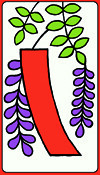
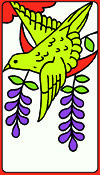 A blank red ribbon and a cuckoo are the subjects of today's cards.
A blank red ribbon and a cuckoo are the subjects of today's cards.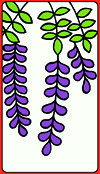
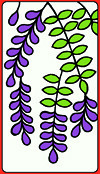 I got all fancy with the pine and peonies, but I went back to basics for April's wisteria suit. Actually looks a bit dull in comparison, doesn't it? Since it isn't very exciting, here's half the suit for you to enjoy!
I got all fancy with the pine and peonies, but I went back to basics for April's wisteria suit. Actually looks a bit dull in comparison, doesn't it? Since it isn't very exciting, here's half the suit for you to enjoy!
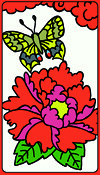 I saved the best peony card for last: here is the suit's animal. Every hanafuda site I have found simply identifies it as 'butterfly.' Since I made fancy peonies, I figured I'd might as well pick a fancy butterfly to go along with them, so I used a swallowtail for reference. Fly, little swallowtail, fly! Be wary of the ominous red clouds above you.
I saved the best peony card for last: here is the suit's animal. Every hanafuda site I have found simply identifies it as 'butterfly.' Since I made fancy peonies, I figured I'd might as well pick a fancy butterfly to go along with them, so I used a swallowtail for reference. Fly, little swallowtail, fly! Be wary of the ominous red clouds above you.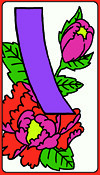 This card introduces another ribbon variation: the blue (in Korean decks) or purple ribbon (in Japanese decks). This is the third and final style of ribbon in hanafuda, including the blank red ribbons and 'poem' ribbons. Two other purple ribbons are yet to come.
This card introduces another ribbon variation: the blue (in Korean decks) or purple ribbon (in Japanese decks). This is the third and final style of ribbon in hanafuda, including the blank red ribbons and 'poem' ribbons. Two other purple ribbons are yet to come.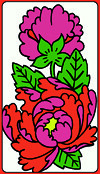 With my peony art, I made another break from contemporary drab hanafuda designs. I wasn't satisfied with what I could find in source material, and real-life peonies are complicated flowers, so I wondered: what other art form specializes in simplifying images? But of course, tattoos!
With my peony art, I made another break from contemporary drab hanafuda designs. I wasn't satisfied with what I could find in source material, and real-life peonies are complicated flowers, so I wondered: what other art form specializes in simplifying images? But of course, tattoos!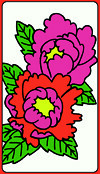 Say hello to the first card from June's peony suit! If there's such a thing as a 'standard' suit in hanafuda, this is as close as it comes: we've got two junks, one ribbon, and one animal card (with an actual animal drawn on it this time). If you've been paying attention, you might be able to figure out on your own that this is junk #1.
Say hello to the first card from June's peony suit! If there's such a thing as a 'standard' suit in hanafuda, this is as close as it comes: we've got two junks, one ribbon, and one animal card (with an actual animal drawn on it this time). If you've been paying attention, you might be able to figure out on your own that this is junk #1.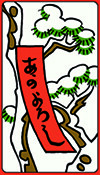 The pine suit contains the second 'poem' style red ribbon. This card rounds out the suit, and I'm so pleased with how it turned out, that I've decided to experiment more with the upcoming months.
The pine suit contains the second 'poem' style red ribbon. This card rounds out the suit, and I'm so pleased with how it turned out, that I've decided to experiment more with the upcoming months.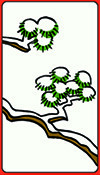 I mentioned that my pine cards are very unlike those in hanafuda decks you can buy at 7-11s all over Japan, but this style is not without precedent. In
I mentioned that my pine cards are very unlike those in hanafuda decks you can buy at 7-11s all over Japan, but this style is not without precedent. In 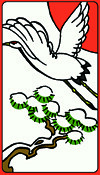
 There's a wide difference here between my original design (right) and the final card with my snowy pine branches. This card has an animal on it, but it's not an "animal" card; it's a "bright."
There's a wide difference here between my original design (right) and the final card with my snowy pine branches. This card has an animal on it, but it's not an "animal" card; it's a "bright."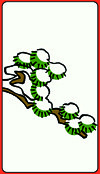
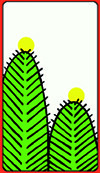 I made a huge break with convention on this suit, which represents the month of January. On the right, my first attempt, a pine card in the modern 'stumpy' style. It looks... okay... but nothing like the Japanese pine that I love to see and draw. So I went oldschool on it and came up with the design to your left, featuring snow-covered branches inspired by a Hokusai woodblock print.
I made a huge break with convention on this suit, which represents the month of January. On the right, my first attempt, a pine card in the modern 'stumpy' style. It looks... okay... but nothing like the Japanese pine that I love to see and draw. So I went oldschool on it and came up with the design to your left, featuring snow-covered branches inspired by a Hokusai woodblock print.